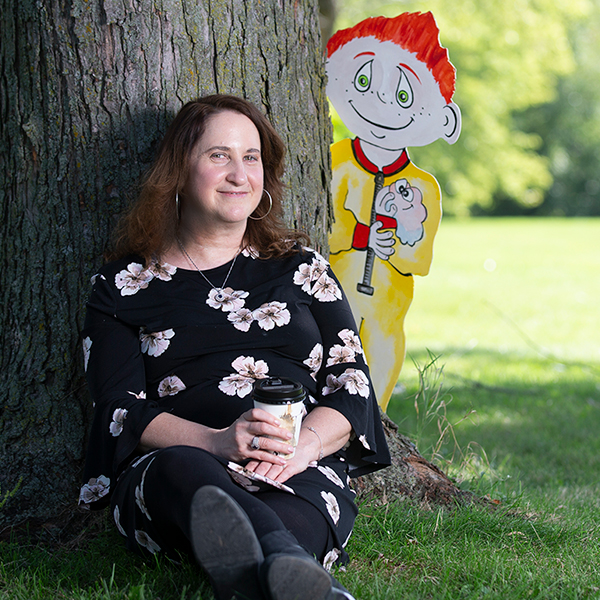It all started when a friendly furniture store salesperson produced a quarter from behind five-year-old Jay Olson’s ear. His parents were just looking for a sofa, but instead they got a son who was hooked on magic.
Olson began his professional career performing magic at age seven, for a sweet 16 birthday party (the party girl was unimpressed by a conjured toy jeep, having wished for a real one), and then went on to perform widely for years at various venues.
But now Olson only demonstrates his magic during McGill lectures. Originally a philosophy student in his home province of B.C., Olson took a shine to cognitive science after he realized that the field’s language was akin to the way magicians talked. “What magicians called misdirection, in psychology they’d call it divided attention,” Olson remarks.
He got to wondering what we could learn about the mind by studying how magicians do what they do – how they utilize the power of suggestion and employ sleight of hand.
Olson, now a doctoral student in psychiatry in the Cognitive Neuroscience Laboratory lab led by associate professor of psychiatry Amir Raz (also a former magician), took a particular interest in the placebo effect.
Though placebos are inert, they often work even when people know they’re placebos. From his professional experience, Olson understands that the power of suggestion is strong, and figured that the context alone of a medical experience – the performance, if you will – could have a significant effect on healing.
Olson set up a pilot study, with assistant professor of psychiatry and anthropology Sam Veissière, MA’05, PhD’07, for children with anxiety and attention disorders who had already undergone conventional treatments with little or no effect.
Olson treated them in a hospital setting, using a non-functional MRI scanner. The kids were explicitly told that the “placebo machine” and all the equipment were only there to help the brain heal itself. One month later, 90 per cent of parents reported that their kids’ symptoms had improved, from reduced fidgeting to better sleep.
Olson recalls a girl with a condition called dermatillomania who obsessively picked at her skin. After two treatments, she picked her skin less often, and after four, she had stopped completely. One year after the experiment, her mother reports that her daughter is happier, feeling more confident, and goofs around like other 13-year-olds.
Though it’s still not clear how it worked, Olson says, “you’re combining all these positive expectations, or people’s mindsets, about what’s going to happen that somehow activate the body’s self-healing mechanisms or help change their motivation to improve in some ways.” Bonus: Placebo-based treatments are safe and inexpensive.
Olson is excited about the medical potential of placebos. He says some studies suggest that the more complicated the placebo is, the more effective it will be. Placebos can be applied to different medical procedures, too. “For example, just giving [patients] verbal suggestions before they go into surgery and [using hypnosis] before surgeries,” says Olson. “In some cases, it can really improve different outcomes they have, like speed up the surgeries and reduce complications.”
Olson recently gave a workshop to appreciative Université de Montréal medical students about the placebo effect, and how to reduce the nocebo effect (when negative expectations lead to worse-than-expected outcomes, which is probably another good reason why you shouldn’t google your condition). Olson says, “I think there’s a lot of room to apply these kind of psychological and social factors in order to improve medicine generally.”
Olson has other tricks up his sleeve, from advising on public speaking (he earned first place in North America at the Council of Graduate Schools’ three minute thesis competition last year) to developing jetlagrooster, a jet-lag prevention app (inspired by a European jaunt that was largely squandered by drowsiness).
He is also applying his circadian rhythm research to nurses who work night shifts. In a recent study, he showed that well-timed bright light exposure helped nurses reduce their fatigue and be more alert. Moods were improved, and fewer errors were made.
Olson cheerfully admits to being hypnotically susceptible himself. Raz lab members routinely hypnotize each other to experience how it works. And he has discovered a correlation between being hypnotizable and being prone to smartphone overuse, another area he’s further researching with Veissiere.
Medical researchers and cognitive scientists aren’t the only ones who are interested in his studies. Olson’s work was featured on a The Nature of Things documentary last year and some of the research done by his team at McGill is currently being showcased as part of the exhibition “Smoke and Mirrors: The Psychology of Magic” at the Wellcome Centre in London, England. Olson’s work is on display there along with artifacts from some of the biggest names in magic, including Harry Houdini.
That five-year-old who once marvelled at a coin that magically appeared from behind his ear would be impressed.


